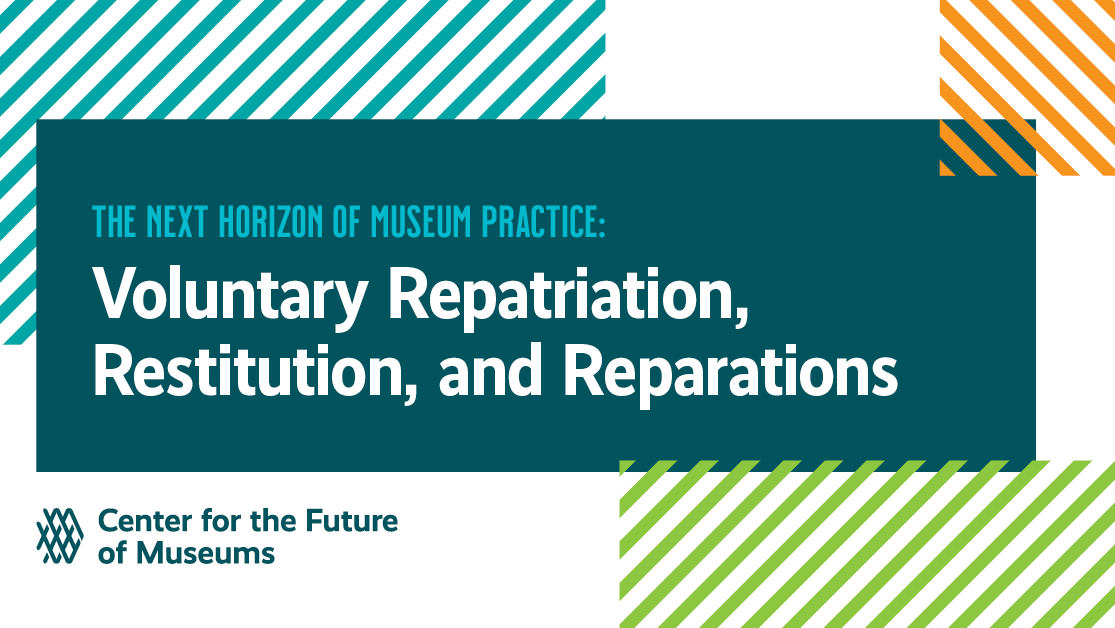
[This blog post introduces the new AAM report The First Horizon: Understanding the State of Voluntary Repatriation, Restitution, and Reparations Today. Download your free copy today.]
Why is it so hard to make change?! Even when we (museum people) know that parts of our work are in urgent need of reform, progress can be glacially slow.
In fact, that’s natural. Humans are hardwired for caution, and it often seems safer to stick with the imperfections of what we know than to venture into unknown territory in search of something better.
One of the superpowers of foresight is that it can help us over that hump, overcoming the inertia that traps us in “business as usual” by encouraging us to imagine, in depth and detail, what a better future could look like. From the perspective of that desired future state, we can apply our ingenuity to overcoming the barriers that lie ahead.
This week the Alliance is helping our sector take the first step along that path with the release of The First Horizon: Understanding the State of Voluntary Repatriation, Restitution, and Reparations Today. This report launches an AAM project that will help our sector envision preferred futures for museums’ relationships with descendant communities, as embodied in the practices of voluntary repatriation, restitution, and reparations.
The text introduces the Three Horizons framework guiding this work (which, incidentally, is a useful tool for strategic planning, as well) and presents a snapshot of recent history and current practice. From this foundation, we will build the next two stages of the project: recruiting a diverse array of writers to share their visions of preferable futures of museum practice; and helping individual museums and our sector as a whole plot a navigable path to those futures.
What will you find in the report?
- A brief guide to the Three Horizons framework, designed by the International Futures Forum to help individuals, organizations, and sectors “explore innovation and take wise action” in the face of uncertainty and overcome the most frequent barriers to change.
- An explanation of the scope and terminology of the project
- A recent timeline of voluntary repatriation, restitution, and reparations
- A preview of the next stages of the project, including how you can be involved
- Brief essays addressing
- The relationship between law and ethics
- Why we should tell stories about potential futures (drawing on my personal experience with NAGPRA)
- The complexities of repatriation and restitution
- A worksheet to help you record initial thoughts on this exploration
How is this report relevant to your museum?
This project specifically addresses four descendant communities:
- Descendants of people trafficked to the US in the transatlantic slave trade
- Indigenous peoples of the Pacific and the Americas
- Indigenous peoples of sub-Saharan Africa
- Jewish communities, families, individuals, and descendants of those harmed by persecution during the Nazi era
If your museum serves any of these communities, or holds related collections, it’s probably clear how this project relates to your work. I’ll make the case that it is relevant to all museums as well. Every museum in the US exists on land stolen from Indigenous peoples; every museum in the US has benefited, directly or indirectly, from the wealth built on the slave trade. I hope this report can be a starting point for conversations about what obligations those legacies may entail.
What’s next?
Follow this project here on the blog and on its home page at bit.ly/reparative-practices
Please plan to join me for a workshop at the AAM Annual Meeting and MuseumExpo in Baltimore next May to learn more about these foresight techniques, and help us build out visions for preferable futures of museum practice.
Meanwhile, I look forward to reading your thoughts and reactions in the comments section below.
Warmest regards from the future,
Elizabeth Merritt
Vice President, Strategic Foresight and Founding Director, Center for the Future of Museums









Thank you for your article. Although we are a small non-profit historical society with a museum in South Jersey, we have been doing our best to repatriate human remains and other artifacts to more appropriate hands since I arrived here in 2011. In addition to sending skulls home to the local Lenni Lenape, we discovered that we owned the remains of Nez Perce tribe members who were massacred at the Battle of Bear Paw Mountain and returned the remains accordingly. We are continuing to sift through our collections and will maintain this standard in the years to come.
A Native colleague recently asked me, gently but bluntly,”Why won’t your museum return these ancestral remains?” I was at a loss to explain all the forces at work against this simple and inarguable request–much less what we could do to overcome those forces. Your project’s thought-provoking approach to positive change offers a ray of hope.